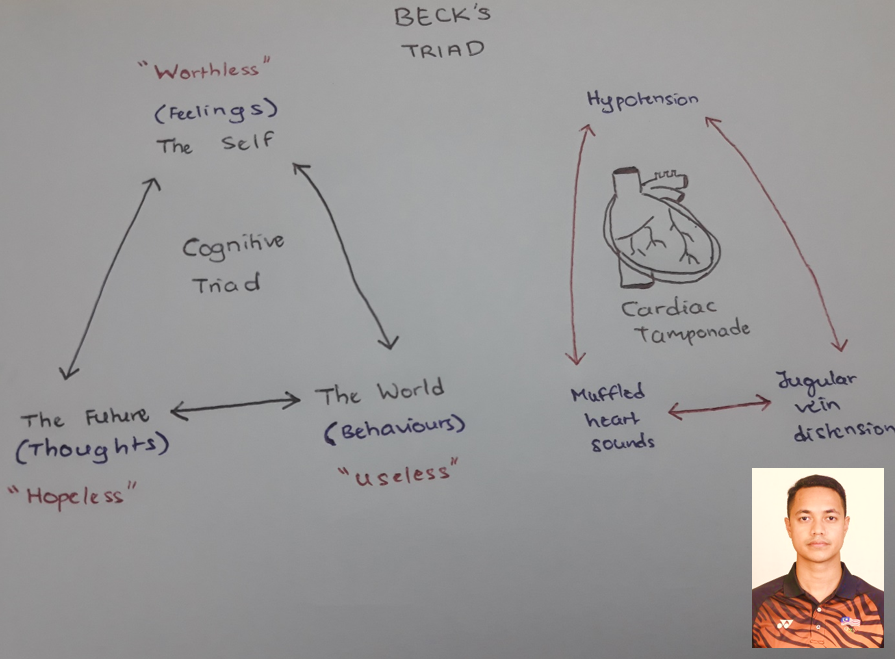When it comes to treating an illness, most healthcare professionals look at the disease aspect rather than the patient background due to many factors coming from both the prescriber and the seeker. This perspective emphasizes on single causal factor which is reductive in nature, focusing on the illness specifically than health in general, leading to mind-body dualism practice in therapy. As such, it is not a holistic approach in medical field practice. Bio-Psycho-Social-Spiritual Model is created and later, adopted to gain this purpose of wholesome treatment for patients.
Taking a peek into triads in medical physiology and psychology, one cannot miss to encounter this important triad; Beck’s Triad. Both are derived from different medical doctors of different fields of specialisation and at different times in the 20th century, albeit the similar family name.
Beck’s Triad (1935)
This triad is formulated to assess for cardiac tamponade by Prof. Claude Schaeffer Beck, the pioneer American cardiothoracic surgeon, in 1935. He is also been credited as the first doctor to perform successful defibrillation in 1947, which in turns being used worldwide up until now as part of Basic Life Support (BLS) skills for medical personnel along with the later invention of Automated Defibrillation Device (AED) for non-medical people usage. Cardiac tamponade is a medical emergency when excessive fluid accumulates in the pericardial sac around the heart and impairs its ability to pump blood. This life-threatening condition is caused by chest trauma (both blunt and penetrating), myocardial infarction, myocardial rupture, cancer (Hodgkin lymphoma in common), uraemia, pericarditis, or cardiac surgery (usually in the first 7 days post-op). It is characterized as follows;
1. Hypotension with a narrowed pulse pressure (low blood pressure: <90/60mmHg)
2. Jugular venous distention (obvious distension of the neck veins, seen by naked eye)
3. Muffled heart sounds (“silenced heart”: murmur-like sound upon auscultation)
Beck’s Triad (1967)
Prof. Aaron Temkin Beck, an American psychiatrist, identified 3 automatic negative thinking that are alleged to be responsible for the propagation of depression in 1967. He has earlier published the famous Beck Depression Inventory (BDI) in 1961, later being revised in 1978 and 1996 as well as being used all over the world in screening for depressive disorder. Major Depressive Disorder (MDD) is a mental disorder characterized by at least two weeks of pervasive low mood: anhedonia (loss of interest), avolition (loss of intention/energy/will), alogia (loss of speech) and affective flattening (loss of emotions). Through BDI screening, his pioneering theories are later developed into what we called today as Cognitive Behavioural Therapy (CBT), that is widely-used to treat clinical depression and anxiety disorders. The triad of negative conditions which plays major role in leading to depression are listed below;
1· The self (feelings): “Worthless”
2· The world or environment (behaviour): “Useless”
3· The future (thoughts): “Hopeless”
Looking into both Beck’s Triads; their founders’ efforts, the theories behind it and the impact that they had into the lives of many people from all walks of life and from all over the world, it is suffice to say that these two Becks contributed massively into the implementation of Bio-Psycho-Social-Spiritual Model as an interplay of all factors leading to unity of mind and body in treating an ill person as a whole. Combining both cardiac tamponade and MDD together, the heart condition is more of acute-on-chronic nature as it is caused by other chronic heart diseases in the likes of Acute Coronary Syndrome (ACS) and Hodgkin lymphoma (cancer), which in turns leads to mood and behavioural changes due to its chronicity affecting the patients’ health burden, straining interpersonal relationships, fractured faith in religions, thus resulting a low Quality of Life (QOL). In short, these Beck’s Triads showed to us that what matters most is regardless of an acute life-threatening event happening which prompt an immediate recognition and intervention or even a chronic undulating situation which also in need of instantaneous identification as well as interposition by the healthcare professionals from multidisciplinary fields to subdue the illness and revive the health simultaneously.
By:
Dr. Mohd Khairul Azizi Bin Mohd Zaki
MBBS (IIUM), IOC Dip Sp Phy (Lausanne)
Lifestyle Science Cluster, AMDI USM


